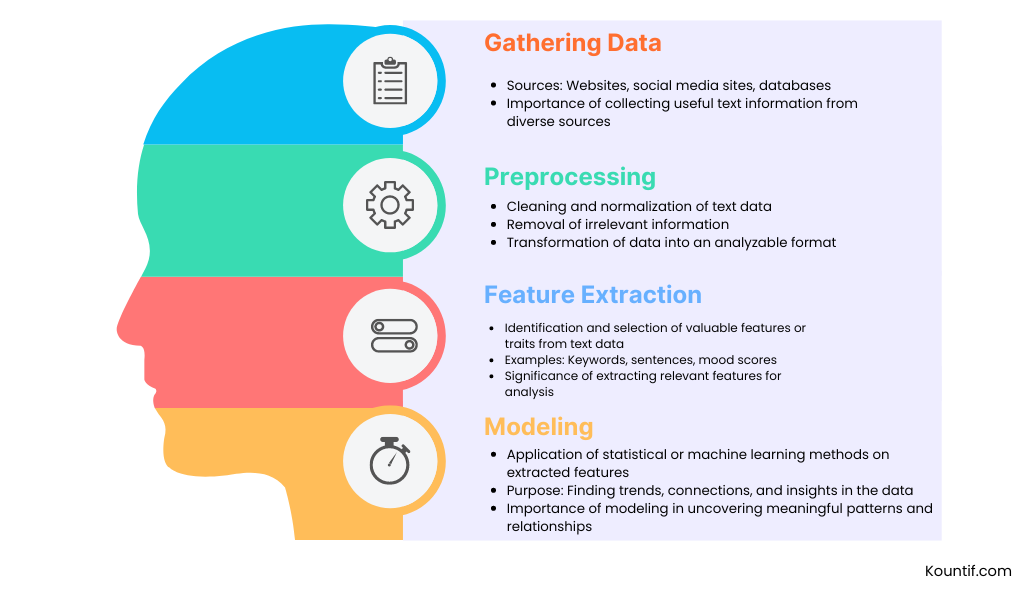
Text analysis is a powerful tool for getting valuable data from vast amounts of messy data in today’s data-driven world. Textual analysis uses machines to read, understand, and get from written data sources. Word processing or text mining are other names for it. As quickly as the amount of digital information grows, companies, students, and people in charge of making decisions in many fields must be able to read and understand text better.
Table of Contents
ToggleWhat is Text Analysis?
Text analysis uses algorithms and statistical methods to extract meaningful information and insights from unstructured text data, such as documents, social media posts, customer reviews, and emails.
By applying techniques like keyword extraction, sentiment analysis, and topic modeling, text analysis enables users to uncover hidden patterns, trends, and relationships within large volumes of text data, which can then be used to inform decision-making and drive business value.
Why is Text Important in the Information Age?
In this modern world, text data is everywhere and is used by many different types of businesses. Text data, which includes customer reviews, social media posts, news stories, and study papers, has a lot of helpful information that can be used to get ahead of the competition, improve the customer experience, and spark new ideas.
Text data analysis can help businesses learn much about customer tastes, market trends, and new business possibilities. This lets them choose based on data and stay ahead of the curve.
Fundamentals of Text Analysis
It involves several key steps, including data extraction of information, understand meaning and processing data. These steps are essential to get accurate insights from text data.
Extracting Information
Getting helpful information from random text data is one of the most important parts of text analysis. This can be done with tools like understanding objects and phrase identification. Finding the most common and important words or sentences in a text collection is called keyword identification. On the other hand, finding and labeling named things, like people, places, and organizations, is called entity recognition. Organizations can turn unorganized data into established forms easy to study and display by getting out essential information from text data.
Understanding Meaning
Text examination involves more than just getting out information; it also includes discovering what the text data means and how it fits into its surrounding context. Techniques like topic modeling and mood analysis can help you find the ideas, feelings, and themes hidden in text data. Natural language processing methods are used in emotion analysis to determine the emotional tone or mood in a piece of writing, such as whether it is positive, negative, or neutral. On the other hand, topic modeling is the process of finding the central ideas or themes in a group of papers. This lets users find trends and connections that were not simple before.
The Process of Text Analysis
Analyzing text usually has a few main steps, such as gathering data, preparing it, extracting features, and modelling them.
- Collecting data means getting useful text information from a number of places, like websites, social media sites, and databases.
- Preprocessing cleans and normalizes the text data, removes of information that isn’t needed, and changes the data into a shape that can be analyzed. Finding and choosing useful features or traits from text data, like keywords, sentences, or mood scores, is what feature extraction is all about.
- Modeling is the process of using statistical or machine learning methods on the features that have been taken to find trends, connections, and insights in the data
Applications of Text Analysis
Analysis of texts can be used in many different areas and businesses. Here are some common ones:
Making Decision-Making Easier
Text evaluation is essential for making decisions based on facts in many areas. By getting ideas from vast amounts of text data, businesses can learn more about what customers want, how the market changes, and new business possibilities. This helps them make better, more intelligent decisions.
For example, a store can look at customer reviews and comments to find ways to improve their products. On the other hand, a bank can read reports and social media posts to see risks and chances in the market.
Enhancing Customer Experience
The study of text can also be used to improve the customer experience by looking at comments and reviews left on social media, emails, and chat records, among other places. Businesses can find ways to improve their products or services by using emotion analysis to learn what customers think and what they like. They can also make their products and services fit customers’ needs and make text-based conversations more personal for users.
For example an e-commerce company that can use statistical analysis of texts to suggest products to customers based on their past purchases and tastes. Another example is a hotel chain that can read customer reviews to find common problems and make changes to make guests happier.
Market Research and Competitive Analysis
Text analysis can be valuable for studying the market and your competitors. Companies can learn about market trends, customer tastes, and the competition by reading industry studies, news stories, and social media talks. This can help you stay ahead of the competition, find market chances and threats, and make product creation and marketing decisions.
For example, a tech business might look at patent applications and study papers to find new technologies and possible rivals. A consumer goods company, on the other hand, might look at social media talks to learn about customer tastes and trends.
Fraud Detection and Security
Evaluation of texts can also be used to find scams and keep things safe. Organizations can discover trends and unusual things that may point to fraud or security threats by looking at a lot of text data, like transaction records, customer exchanges, and social network posts.
For example, A bank can use text analysis to find deals that don’t seem right or activities that involve moving money. A cybersecurity company, on the other hand, can look at threat intelligence reports and social media talks to find possible cyber threats and weaknesses.
Political and Social Analysis
Text analysis is a solid way to learn about how people feel and what the current trends are. Researchers and experts can understand how people think about different problems by looking at text data from news stories, online forums, talks, and other sources. They can also see how people’s opinions change and find areas of worry or opportunity.
For example, A political campaign can analyze texts to determine voters’ wants and change their messages. A government office, on the other hand, can use public comments to help make policy decisions and make services better for everyone.
Healthcare and Medical Research
Medical study and healthcare both use text analysis in meaningful ways. Healthcare professionals and scholars can find patterns and trends to help them make clinical decisions and plan research by looking at medical texts like patient records, clinical notes, and research papers.
For example, Based on clinical data and patient feedback, analysis of the text can be used to find lousy drug effects, guess how patients will do, and find new treatment choices.
Legal and Compliance
Lawyers and people who work in law can also use text evaluation to find areas of risk and violations. By looking at legal papers, contracts, and other text data sources, businesses can discover possible legal problems, ensure they follow the rules, and improve their legal decisions.
For example, A bank can use text analysis to find possible rules violations against money laundering, and a doctor or nurse can look at patient records to ensure they align with privacy and security regulations.
Academic and Research Applications
Text analysis has many valuable uses in school and study settings. Researchers can find developments and patterns in their areas of study, find new research opportunities, and get ideas for planning and carrying out their studies by reading academic books, research papers, and other educational sources.
For example, Text analysis can be used in linguistics to look at changes in patterns in language across different text samples. On the other hand, sociologists can use it to look at news stories and social media talks to find out what people think about various topics.Try Some Tools Sentence Counter and Syllable Counter.
Quick Overview of Applications
| Industry/Field | Text Analysis Application | Benefits |
|---|---|---|
| Customer Service | Sentiment Analysis, Topic Modeling | Improved customer experience, Reduced complaints |
| Marketing | Keyword Extraction, Social Media Monitoring | Enhanced brand reputation, Increased customer engagement |
| Fraud Detection | Anomaly Detection, Pattern Recognition | Reduced financial losses, Improved security |
| Healthcare | Medical Text Analysis, Patient Feedback Analysis | Improved patient outcomes, Enhanced medical research |
| Social Media | Sentiment Analysis, Trend Analysis | Increased social media engagement, Better crisis management |
| Legal | Contract Analysis, Compliance Monitoring | Reduced legal risks, Improved regulatory compliance |
| Research | Text Mining, Topic Modeling | Accelerated research discoveries, Improved academic productivity |
Benefits
- Text analysis makes it easier to make decisions based on facts.
- It helps businesses be more productive and efficient and perform better overall.
- Finding trends and connections that are hidden in significant amounts of text data.
- It leads to new findings and the creation of new information.
- Brings about new ideas and progress in many areas.
Challenges
- Keeping data private and safe while personal information is being analyzed is difficult.
- Taking steps to stop wrong or unfair results from happening by reducing the risk of bias in training data and algorithms.
- Firm data control and ethics models guide how text analysis is done.
- Keeping things open and responsible during the whole process of text analysis.
- To maintain high standards and deal with problems, algorithms, and models are constantly checked and improved.
Conclusion
It has become clear that text analysis is a solid way to get helpful information from vast amounts of random text data. Analysis of texts can help businesses make better decisions, give customers a better experience, and develop new ideas in many areas by letting them pull information, figure out what it all means, and gain insights from text data. Text evaluation will become more and more critical as the amount and variety of text data increases. This means that people and businesses must be able to do it well.
FAQs
Why is it beneficial to analyze texts?
The analysis of text has many benefits, such as making it easier to make decisions based on data, increasing efficiency and productivity, finding new information and finds, promoting growth and innovation in many areas, and making the customer experience better.
What are the challenging parts of analyzing texts?
Making sure data is private and safe, lowering bias in algorithms and training data, setting up firm data control and ethics frameworks, and constantly checking and improving algorithms and models are some of the problems.
What is the significance of analyzing texts?
The study of text is used in many fields to help people make decisions, improve the customer experience, do market research and competitive analysis, find fraud and keep people safe, do political and social analysis, do medical research and healthcare, make sure laws are followed, and do research and academic work.










